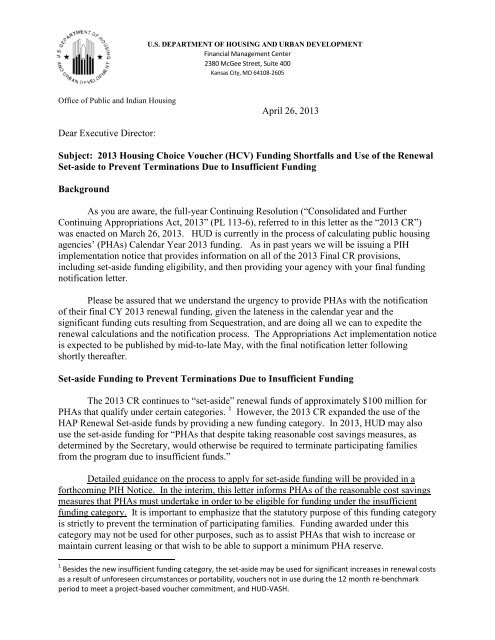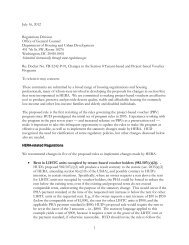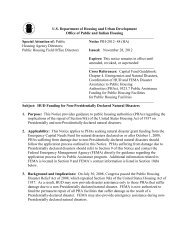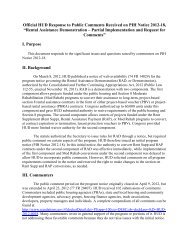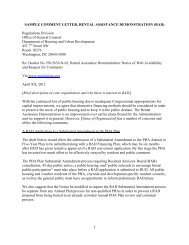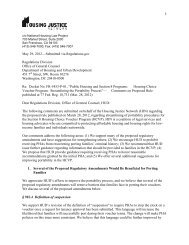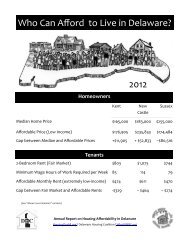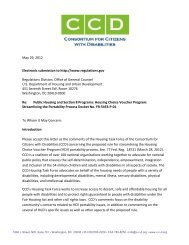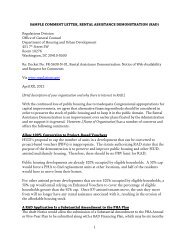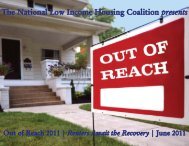Housing Choice Voucher funding shortfalls and use of ... - ncsha
Housing Choice Voucher funding shortfalls and use of ... - ncsha
Housing Choice Voucher funding shortfalls and use of ... - ncsha
You also want an ePaper? Increase the reach of your titles
YUMPU automatically turns print PDFs into web optimized ePapers that Google loves.
U.S. DEPARTMENT OF HOUSING AND URBAN DEVELOPMENT<br />
Financial Management Center<br />
2380 McGee Street, Suite 400<br />
Kansas City, MO 64108-2605<br />
Office <strong>of</strong> Public <strong>and</strong> Indian <strong>Housing</strong><br />
April 26, 2013<br />
Dear Executive Director:<br />
Subject: 2013 <strong>Housing</strong> <strong>Choice</strong> <strong>Voucher</strong> (HCV) Funding Shortfalls <strong>and</strong> Use <strong>of</strong> the Renewal<br />
Set-aside to Prevent Terminations Due to Insufficient Funding<br />
Background<br />
As you are aware, the full-year Continuing Resolution (“Consolidated <strong>and</strong> Further<br />
Continuing Appropriations Act, 2013” (PL 113-6), referred to in this letter as the “2013 CR”)<br />
was enacted on March 26, 2013. HUD is currently in the process <strong>of</strong> calculating public housing<br />
agencies’ (PHAs) Calendar Year 2013 <strong>funding</strong>. As in past years we will be issuing a PIH<br />
implementation notice that provides information on all <strong>of</strong> the 2013 Final CR provisions,<br />
including set-aside <strong>funding</strong> eligibility, <strong>and</strong> then providing your agency with your final <strong>funding</strong><br />
notification letter.<br />
Please be assured that we underst<strong>and</strong> the urgency to provide PHAs with the notification<br />
<strong>of</strong> their final CY 2013 renewal <strong>funding</strong>, given the lateness in the calendar year <strong>and</strong> the<br />
significant <strong>funding</strong> cuts resulting from Sequestration, <strong>and</strong> are doing all we can to expedite the<br />
renewal calculations <strong>and</strong> the notification process. The Appropriations Act implementation notice<br />
is expected to be published by mid-to-late May, with the final notification letter following<br />
shortly thereafter.<br />
Set-aside Funding to Prevent Terminations Due to Insufficient Funding<br />
The 2013 CR continues to “set-aside” renewal funds <strong>of</strong> approximately $100 million for<br />
PHAs that qualify under certain categories. 1 However, the 2013 CR exp<strong>and</strong>ed the <strong>use</strong> <strong>of</strong> the<br />
HAP Renewal Set-aside funds by providing a new <strong>funding</strong> category. In 2013, HUD may also<br />
<strong>use</strong> the set-aside <strong>funding</strong> for “PHAs that despite taking reasonable cost savings measures, as<br />
determined by the Secretary, would otherwise be required to terminate participating families<br />
from the program due to insufficient funds.”<br />
Detailed guidance on the process to apply for set-aside <strong>funding</strong> will be provided in a<br />
forthcoming PIH Notice. In the interim, this letter informs PHAs <strong>of</strong> the reasonable cost savings<br />
measures that PHAs must undertake in order to be eligible for <strong>funding</strong> under the insufficient<br />
<strong>funding</strong> category. It is important to emphasize that the statutory purpose <strong>of</strong> this <strong>funding</strong> category<br />
is strictly to prevent the termination <strong>of</strong> participating families. Funding awarded under this<br />
category may not be <strong>use</strong>d for other purposes, such as to assist PHAs that wish to increase or<br />
maintain current leasing or that wish to be able to support a minimum PHA reserve.<br />
1 Besides the new insufficient <strong>funding</strong> category, the set-aside may be <strong>use</strong>d for significant increases in renewal costs<br />
as a result <strong>of</strong> unforeseen circumstances or portability, vouchers not in <strong>use</strong> during the 12 month re-benchmark<br />
period to meet a project-based voucher commitment, <strong>and</strong> HUD-VASH.
To be eligible for the set-aside <strong>funding</strong> to prevent terminations due to insufficient<br />
<strong>funding</strong>, a PHA must meet the following requirements:<br />
(1) At the time <strong>of</strong> application, the PHA is working with the HUD Shortfall Prevention<br />
Team, <strong>and</strong> HUD Shortfall Prevention Team has confirmed the PHA is in a shortfall<br />
position. (PHAs that are not currently working with the Shortfall Prevention Team<br />
but believe they are in a shortfall position should immediately contact their HUD<br />
Field Office for assistance.)<br />
(2) The PHA has ceased issuing vouchers to applicants. (Please note this does not apply<br />
to families that are participants <strong>and</strong> were issued a voucher to move to a different unit.<br />
This restriction is also not applicable to tenant protection vouchers that are being<br />
issued to targeted families that were residing in the covered property on the eligibility<br />
event, or where the PHA is leasing homeless veterans under a recent HUD-VASH<br />
allocation. )<br />
(3) The PHA has rescinded or immediately rescinds following receipt <strong>of</strong> this letter any<br />
vouchers remaining on the street that were issued to applicant families on or after<br />
April 1, 2013 <strong>and</strong> has stopped leasing units. Note this does not apply to vouchers<br />
issued under the two exceptions noted in paragraph (2) above. (PHAs were notified<br />
in March that the Sequestration was effective <strong>and</strong> <strong>of</strong> the expected impact on the<br />
proration for 2013 <strong>funding</strong>, as well as provided guidance on how to estimate their<br />
available resources in the wake <strong>of</strong> the Sequestration cuts. Therefore, HUD’s<br />
expectation is that PHAs in shortfall positions would not have been issuing vouchers<br />
at such a late date, or have taken/are taking immediate action to rescind any vouchers<br />
issued in error.) In addition, PHAs may enter into PBV HAP contracts for units that<br />
are under AHAP as <strong>of</strong> the date <strong>of</strong> this letter <strong>and</strong> still meet this condition.<br />
(4) The PHA has ceased or immediately ceases to absorb portable vouchers.<br />
(5) In regard to project-based voucher (PBV) HAP contracts, vouchers are not issued to a<br />
family that wants to voluntarily move. (However, if a unit becomes vacant, the PBV<br />
unit shall be filled with a family from the waiting list.)<br />
A PHA that applies for <strong>funding</strong> under this new category will be required to certify that<br />
the above conditions have been met as part <strong>of</strong> the application process. A PHA that receives setaside<br />
<strong>funding</strong> for the prevention <strong>of</strong> terminations due to insufficient <strong>funding</strong> generally may not<br />
lease any units (with the exceptions noted above) for the remainder <strong>of</strong> the calendar year.<br />
However, should the PHA’s financial situation improve during the course <strong>of</strong> the calendar year,<br />
the PHA may resume leasing but must first notify the Shortfall Prevention Team. Any excess<br />
set-aside <strong>funding</strong> awarded for insufficient <strong>funding</strong> must then be returned to HUD as it was not<br />
needed for its intended purpose.<br />
HUD also recognizes that attrition PHAs (PHAs that are projected to make it through<br />
calendar 2013 without an actual <strong>funding</strong> shortfall by stopping leasing <strong>and</strong> using NRA/reserves)<br />
may find themselves in a shortfall position later in the year should conditions that impact<br />
program costs (e.g., attrition rates <strong>and</strong> per-unit-cost increases) vary from assumptions <strong>use</strong>d to<br />
estimate the PHA’s current financial situation. As a result, the application period for set-aside<br />
<strong>funding</strong> will remain open indefinitely for insufficient <strong>funding</strong> requests, subject to the availability<br />
<strong>of</strong> funds.
As a cost-savings measure to prevent the terminations <strong>of</strong> families due to insufficient<br />
<strong>funding</strong>, HUD has in the past granted waivers to allow PHAs to make payment st<strong>and</strong>ard <strong>and</strong><br />
utility allowance decreases for families under HAP contract effective earlier than the regulatory<br />
provisions allow. These waivers place financial burdens on participating families <strong>and</strong> therefore<br />
are only approved as a last resort to prevent terminations <strong>of</strong> families. Beca<strong>use</strong> the estimated cost<br />
to prevent terminations due to insufficient <strong>funding</strong> at present appears to be less than the amount<br />
<strong>of</strong> set-aside <strong>funding</strong> that is available, the hardship on the families that would result from the<br />
waiver does not appear to be justified at this time. Consequently, HUD is not approving those<br />
types <strong>of</strong> waiver requests at this time but instead will give priority for set-aside <strong>funding</strong> to PHAs<br />
that despite taking the reasonable cost savings measures described above would otherwise still<br />
have to terminate families as the result <strong>of</strong> insufficient <strong>funding</strong>.<br />
HUD has also received questions from concerned PHAs regarding whether a PHA that<br />
believes it may be in a short-fall position should enter into PBV HAP contracts for units that are<br />
under AHAP. Since the set-aside can be <strong>use</strong>d to provide additional <strong>funding</strong> for units that were<br />
under AHAP during the 12 month re-benchmark period, PHAs should proceed to execute PBV<br />
HAP contracts at this time if the terms <strong>and</strong> conditions <strong>of</strong> the AHAP have been met. (PBV HAP<br />
contracts, like tenant-based HAP contracts, may be terminated due to insufficient <strong>funding</strong>.) As<br />
noted above, PHAs that execute PBV HAP contracts for units under AHAP as <strong>of</strong> the date <strong>of</strong> this<br />
letter are still eligible for priority set-aside <strong>funding</strong>, provided the conditions outlined above are<br />
met.<br />
Taking steps to implement necessary cost-savings measures can be a difficult <strong>and</strong><br />
contentious process, <strong>and</strong> HUD encourages PHAs in shortfall situations to consider engaging<br />
families, l<strong>and</strong>lords, <strong>and</strong> other stakeholders throughout this process. In some cases, PHAs facing<br />
<strong>shortfalls</strong> have been able to develop better solutions through active engagement <strong>and</strong> discussions<br />
with their program stakeholders. For example, some PHAs have been successful in working<br />
with l<strong>and</strong>lords to defer rent increases or voluntarily reduce rents. (Please note that PHAs may<br />
not unilaterally reduce the rent to owner in HCV program due to insufficient <strong>funding</strong>.) Also,<br />
engaged stakeholders were able in several cases to get other entities to help fill the <strong>funding</strong> gap,<br />
when PHA efforts to get additional help had been unsuccessful. Public discussion can increase<br />
the stakeholders’ underst<strong>and</strong>ing <strong>of</strong> the PHA’s challenges <strong>and</strong> their willingness to work<br />
constructively together on solutions.<br />
In closing, we do underst<strong>and</strong> the difficulties PHAs face in administering the HCV<br />
program, given the <strong>funding</strong> cuts in both HAP <strong>and</strong> administrative fee <strong>funding</strong>. We hope that<br />
careful management <strong>of</strong> the set-aside <strong>funding</strong> will help alleviate some <strong>of</strong> the pressures that<br />
shortfall agencies are under <strong>and</strong> by working together we can prevent financial hardship on the<br />
families we assist. If you have concerns about your agency’s <strong>funding</strong> position, please do not<br />
hesitate to contact your local HUD Field Office.<br />
Sincerely,<br />
Michael S. Dennis<br />
Director<br />
Office <strong>of</strong> <strong>Housing</strong> <strong>Voucher</strong> Programs


